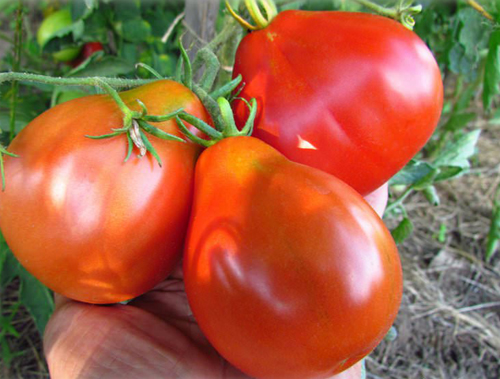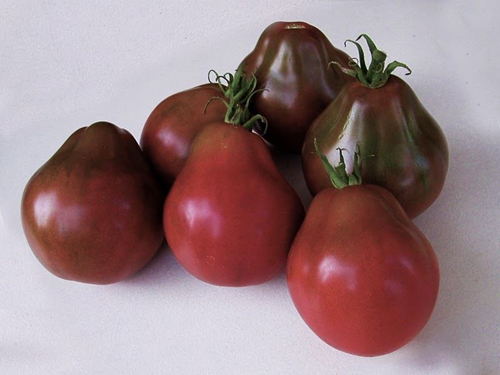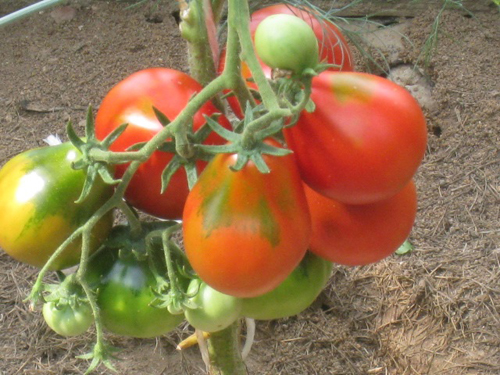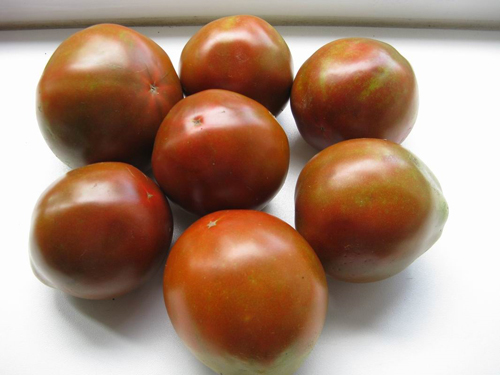Tomato variety Japanese truffle
Tomatoes, united by one common name - Japanese truffle, have a very interesting shape, it really resembles everyone's favorite candy with that name. In addition to the unusual shape, the creators also offer a variety of colors. Tomatoes of the Japanese Truffle series look aesthetically pleasing both on a festive table and in an ordinary vitamin salad. But the series is not only beneficial for this - almost all reviews about the taste of the fruit are very high. The seeds of these colorful tomatoes are distributed under the Biotekhnika brand. The varieties are not included in the State Register of Breeding Achievements of the Russian Federation, but many tomato growers in Russia and Ukraine are well acquainted with them, and not only by hearsay. All varieties are not hybrids, so seeds for further breeding can be harvested on their own.

Red
It should be noted that the characteristics of all varieties are the same, as are the agrotechnical methods. Therefore, we will consider what features are inherent in the culture as a whole, and then we will understand the nuances.
Description
Tomatoes of the Japanese truffle series are indeterminate plants, up to 1.5 meters high. Stems of medium thickness, moderate shoot formation, medium leafiness. The leaves are green, of the usual tomato type (except for the black variety, it has a potato type of leaf plate), the surface of the leaf is slightly corrugated. The stem and shoots are pubescent. Each fruit cluster has 5 to 6 ovaries. The peduncle is articulated.

The black
Fruits of an interesting shape, a bit like a pear, but have longitudinal ribbing along the entire surface. A distinctive feature of all varieties is a very shiny skin (especially in orange and gold). The average weight of tomatoes is 100 - 150 grams. When unripe, the fruits are light green with a contrasting spot at the stalk. During the ripeness period, they are painted in a color characteristic of a particular variety (red, gold, black, orange, pink), the spot disappears. The pulp is moderately dense, fleshy, not watery. Taste qualities of all varieties are good and excellent, but there are some nuances, which we will talk about below.

Gold
Characteristics
- The varieties of the Japanese truffle are suitable for indoor and outdoor cultivation;
- in terms of ripening, they are mid-ripening, from the moment of full sprouting to the beginning of ripening, 110 - 120 days pass;
- the yield is average, from one bush it is possible to collect 1.5 - 2 kg of tomatoes. But there are data on 4.5 kg of fruits per plant;
- fruiting lasts from July to early September or a little longer, depending on the region and growing conditions;
- unripe harvest is perfectly ripened;

Red
- the varieties have good immunity, there is a general high resistance to fungal and viral diseases, but there are exceptions in the form of apical rot;
- at high humidity, the fruits may burst at the stalk;
- varieties differ in average cold resistance, but in cold regions it is still better to grow tomatoes in greenhouses or in the open, while being able to quickly install light cellophane shelters in case of a sharp cold snap;
- the transportability and keeping quality of the fruits of the Japanese truffle are good;
- the way of eating tomatoes is universal. Fruits of various colors are equally good fresh and are used for canning.

The black
Agrotechnics
If it is planned to grow varieties in the open field, then the seeds are sown in March, so that by the time of planting the seedlings will be 60 - 65 days old. If you are preparing to cultivate plants indoors, then sowing seeds should be done in February. The seeds are small, so they should not be buried more than 2 cm. The pick is carried out in the phase of 2 true leaves. For 1.5 - 2 weeks before planting, hardening is carried out, gradually accustoming the seedlings to new conditions. The recommended planting density for tomatoes is 4 plants per square meter. Some time after disembarkation, a garter is carried out on trellises.In order for the variety to show the best result, the bush is formed into 2 or 3 stems. The rest of the stepsons are cut off. It is also advisable to tie up the fruit clusters of the Japanese truffle, as there is a problem with creases.
The care is standard for the culture as a whole. When ripe, there may be a problem in the form of green shoulders. To avoid it, the bushes are fed with potash fertilizers. But not only they should be in the plant's diet. In order for the culture to develop at a good pace, and the formed fruit clusters to ripen, it is necessary to use complex universal fertilizers. Try not to overmoisten the soil, especially in the greenhouse, otherwise the skin of the fruit will begin to crack, and they may also be affected by the top rot.
Now let's dwell on each variety of the Japanese truffle separately.
- The red-fruited variety is considered the best for canning and processing. It has a great taste, combining sweetness with a slight sourness and a pleasant tomato aroma. Even in a ripe fruit, greenish or yellow spots often remain near the stalk. This tomato is highly resistant to late blight.
- The golden Japanese truffle is extraordinarily beautiful. The taste is sweet, the aroma is delicate, tomato-fruity. Fruit transportability is good. Many gardeners appreciate this variety for its good keeping quality, however, for this you need to pick tomatoes at the stage of blanche ripeness.
- Black-fruited tomato is colored in red-brown-black tones. The taste is good, sweetish, the flesh is firm, not watery. This variety can also sin with green shoulders, which, even when ripening, may not disappear.
- Orange truffle has a very beautiful fruit appearance and rich orange color. But many people call its taste bland.
- Pink is also attractive in appearance; at the stage of consumer ripeness it becomes deep pink. But about the taste again controversy. Someone has it bland, someone really likes it.
Japanese truffles are a successful series of colorful varieties that look great as a variegated mix in a jar or salad. They are quite unpretentious in care, especially since agricultural technology is standard for all varieties. Taste qualities directly depend on the climate, and therefore on the literacy of cultivation. Observing the rules of care, you can avoid problems in the form of cracked skin and diseases. Many who have tried to grow these bright tomatoes are not going to give them up in the future. One drawback for all is the need for a garter and shaping.








